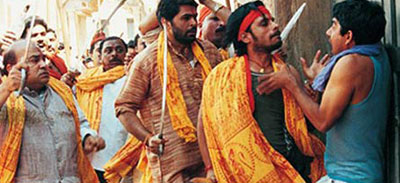Laleh Habib reports on a recent talk by Dr Sunera Thobani at LSE’s Gender Institute.
At a recent talk organised by the Gender Institute, Visiting Fellow Dr Sunera Thobani shared her latest research on the relationship between violence, religion and national identity, as portrayed in four Bollywood films depicting communal violence in Gujarat in 2002.
Addressing a packed audience, Dr Thobani reflected on the way the violence in Gujarat in 2002 had been portrayed in four Bollywood films: Dev (2004), Parzania (2007), Firaaq (2008), and Road to Sangam (2009). This depiction, she argued, reveals and informs concepts of national identity, politics and citizenship. The films also represent the ways in which the nation grapples with the meaning of this collective violence, and the processes through which it can move forward.
With imminent general elections in India, questions about Indian national identity and citizenship gain prominence. It is in this context that Dr Thobani’s lecture becomes all the more relevant and timely, especially as Narendra Modi, the Chief Minister of Gujarat during the 2002 anti-Muslim riots, emerges as a serious contender for the position of Prime Minister.
Thobani opened her discussion with an overview of the Gujarat riots of 2002, during which at least 2,000 people were killed, hundreds of women raped, and almost 100,000 left homeless. Since the events, the Gujarat government, headed by the Bharatiya Janata Party (BJP), has been accused of complicity in the violence; at the very least, it was unresponsive in preventing the bloodbath.
While the four films that Thobani studied differ significantly with regards to plotlines, narratives and visual effects, she argued that they are all framed within the paradigm of communalism. In each of the films, the nation and state are portrayed as the real victims of the 2002 violence. Noticeably absent in these productions, she maintained, is any meaningful engagement with the Muslim victims of the massacre. These victims, it appears, have been doubly silenced: through the violence itself, and subsequently through these cinematic depictions, which portray their experiences as almost incidental.
The speaker presented the concept of an “ongoing Partition” as a way to explain the continuing efforts to define national identity, the state, and concepts of citizenship in India. Within this framework, the Gujarat riots become a way of redefining Indian citizenship as religious category. This redefining, Thobani argued, is mirrored in the four movies she examined. In her analysis, each of the films advance and normalise the equation of Hinduism (albeit secular Hinduism) as nationalism. These cinematic depictions suggest that the cause of the collective violence in 2002 in indeed religion and, by extension, that secularism is the solution.
As the animated question and answer session following Dr Thobani’s lecture illustrated, there is a strong need for voices such hers to add to the mainstream narrative, and to articulate those experiences that are being overlooked or silenced. It also reminds us that for a country as diverse as India, there can be no one narrative or identity.
Laleh Habib graduated with a Master’s degree from LSE’s Department of Media and Communication in 2006.







1 Comments